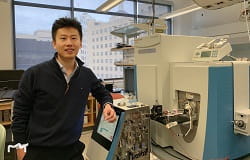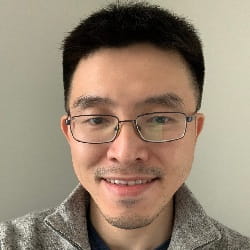
8/3/2021
 “This is the first time anyone has systematically classified ultrapotent nanobodies based on their structure,” said senior author Yi Shi, Ph.D., assistant professor of cell biology at Pitt. “By doing this, we’ve not only provided details on the mechanisms our nanobodies use to defeat SARS-CoV-2, but also revealed directions for how to design future therapeutics.”
“This is the first time anyone has systematically classified ultrapotent nanobodies based on their structure,” said senior author Yi Shi, Ph.D., assistant professor of cell biology at Pitt. “By doing this, we’ve not only provided details on the mechanisms our nanobodies use to defeat SARS-CoV-2, but also revealed directions for how to design future therapeutics.”
 In this latest study, Shi partnered with Pitt structural biologists Cheng Zhang, Ph.D., and James Conway, Ph.D., as well as pharmacologists, structural biologists and biochemists at Case Western Reserve, to use high-resolution cryoelectron microscopy to observe exactly how the nanobodies interact with the SARS-CoV-2 virus to stop it from infecting cells and discover how mutations found in variants may affect nanobody interactions.
In this latest study, Shi partnered with Pitt structural biologists Cheng Zhang, Ph.D., and James Conway, Ph.D., as well as pharmacologists, structural biologists and biochemists at Case Western Reserve, to use high-resolution cryoelectron microscopy to observe exactly how the nanobodies interact with the SARS-CoV-2 virus to stop it from infecting cells and discover how mutations found in variants may affect nanobody interactions.
 “Cryoelectron microscopy has been demonstrated many times to be an extremely useful tool to see high-resolution structural information,” said co-senior author Wei Huang, Ph.D., research scientist in the Department of Pharmacology at the Case Western Reserve School of Medicine. “And nanobodies are versatile and stable biologics that can be used in other research, such as cancer.”
“Cryoelectron microscopy has been demonstrated many times to be an extremely useful tool to see high-resolution structural information,” said co-senior author Wei Huang, Ph.D., research scientist in the Department of Pharmacology at the Case Western Reserve School of Medicine. “And nanobodies are versatile and stable biologics that can be used in other research, such as cancer.”
 Class I outcompetes the part of the human cell that the spike protein binds to, preventing the virus from gaining entry to cells.
Class I outcompetes the part of the human cell that the spike protein binds to, preventing the virus from gaining entry to cells. - Class II binds to a region on the spike protein that has persisted through several permutations of coronaviruses—including the original SARS-CoV-1. This means it may neutralize SARS-CoV-2 and its variants, but also other coronaviruses.
- Class III latches on to a specific region of the spike protein that larger antibodies cannot access. By binding to this area, the nanobody prevents the protein from folding in the way it needs to for entry into human cells.
PHOTO INFO: (click images for high-res versions)
First:
CREDIT: UPMC
CAPTION: Yi Shi, Ph.D., assistant professor of cell biology, University of Pittsburgh.
Second:
CREDIT: CWRU
CAPTION: Three different classes of nanobodies act against a SARS-CoV-2 spike protein.
Third:
CREDIT: CWRU
CAPTION: Wei Huang, Ph.D., research scientist, Department of Pharmacology, Case Western Reserve School of Medicine.
Fourth:
CREDIT: Pitt
CAPTION: The first systematic classification of ultrapotent nanobodies reveals that the microscopic molecules work against SARS-CoV-2 in three ways.
















